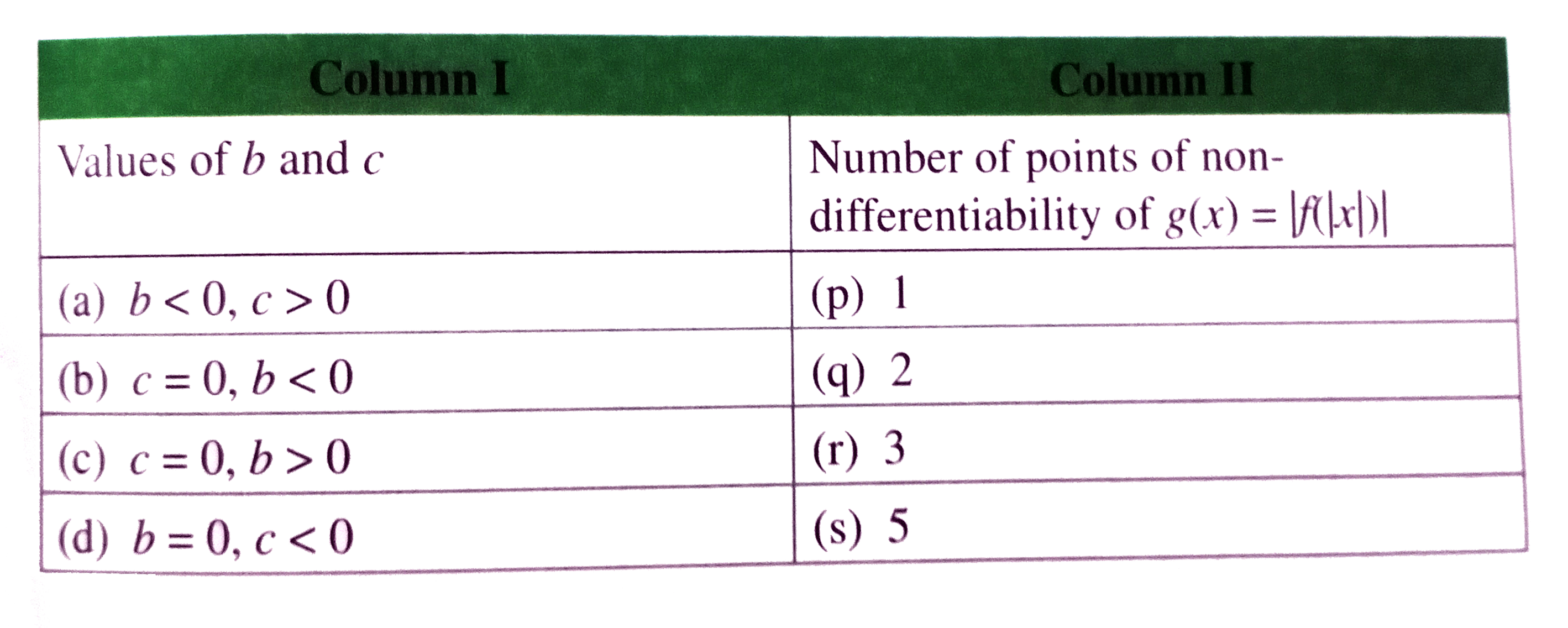Consider the function f(x)=(ax+1bx+2)x, where a,b>0, the limx→∞f(x) is
exists for all values of a and b
zer for a<b
non existent for a>b
e−(1/a) or e−(1/b) if a=b
The correct Answer is:B, C, D
To solve the limit of the function f(x)=(ax+1bx+2)x as x approaches infinity, we will analyze three cases based on the relationship between a and b.
Step 1: Identify the cases based on a and b
We have three cases to consider:
1. Case 1: a<b
2. Case 2: a>b
3. Case 3: a=b
Step 2: Case 1 - a<b
In this case, we analyze the limit:
limx→∞f(x)=limx→∞(ax+1bx+2)x
Dividing the numerator and denominator by x:
=limx→∞(a+1xb+2x)x
As x→∞, 1x and 2x approach 0:
=limx→∞(ab)x
Since a<b, ab<1. Therefore, (ab)x→0 as x→∞.
Step 3: Case 2 - a>b
Now, we analyze the limit for the case where a>b:
limx→∞f(x)=limx→∞(ax+1bx+2)x
Again, dividing by x:
=limx→∞(a+1xb+2x)x
As x→∞:
=limx→∞(ab)x
Since a>b, ab>1. Therefore, (ab)x→∞ as x→∞.
Step 4: Case 3 - a=b
In this case, we have:
limx→∞f(x)=limx→∞(ax+1bx+2)x
Since a=b:
=limx→∞(a+1xa+2x)x
This simplifies to:
=limx→∞(aa)x=1x
This form 1∞ is indeterminate. To resolve this, we can use the logarithmic limit:
limx→∞x(a+1xa+2x−1)
Calculating the expression inside the limit:
=limx→∞x(a+1x−(a+2x)a+2x)=limx→∞x(−1xa+2x)
This simplifies to:
=limx→∞−1a+2x=−1a
Thus, we have:
limx→∞f(x)=e−1a
Conclusion
The limit of f(x) as x→∞ is:
- 0 if a<b
- ∞ if a>b
- e−1a if a=b
1. Case 1: a<b
2. Case 2: a>b
3. Case 3: a=b
- ∞ if a>b
- e−1a if a=b
Topper's Solved these Questions
- LIMITSBOOK - ARIHANT MATHS ENGLISHCHAPTER - LIMITSEXERCISE - Exercise (Passage Based Questions)
13 Videos
- LIMITSBOOK - ARIHANT MATHS ENGLISHCHAPTER - LIMITSEXERCISE - Exercise (Matching Type Questions)
3 Videos
- LIMITSBOOK - ARIHANT MATHS ENGLISHCHAPTER - LIMITSEXERCISE - Exercise (Single Option Correct Type Questions)
39 Videos
- INVERSE TRIGONOMETRIC FUNCTIONSBOOK - ARIHANT MATHS ENGLISHCHAPTER - INVERSE TRIGONOMETRIC FUNCTIONSEXERCISE - Exercise (Questions Asked In Previous 13 Years Exam)
8 Videos
- LOGARITHM AND THEIR PROPERTIESBOOK - ARIHANT MATHS ENGLISHCHAPTER - LOGARITHM AND THEIR PROPERTIESEXERCISE - Exercise (Questions Asked In Previous 13 Years Exam)
2 Videos
Similar Questions
If the function f(x)={3x<012x>0 then limx→0f(x)=
View SolutionConsider the function f(x)=x2+bx+c, where D=b2−4c>0, then match the follwoing columns.

View SolutionFor the function f(x)=2. Find limx→1f(x)
View SolutionConsider the function f(x)={2x≤02x>0 Find limx→2
View SolutionEvaluate limx→∞(1+2x)x
View SolutionIf limx→∞f(x) exists and is finite and nonzero and if limx→∞{f(x)+3f(x)−1f2(x)}=3, then the value of limx→∞f(x) is _______.
View SolutionIf the function f(x) satisfies (lim)x→1f(x)−2x2−1=π,evaluate (lim)x→1f(x)
View SolutionLet f:R→R be a positive, increasing function with
limx→∞f(3x)f(x)=1. Then limx→∞f(2x)f(x) is equal to
View SolutionLet f(x)=absinx+b√1−a2cosx+c, where |a|<1,b>0 then
View SolutionLet f(x) be a real valued function defined for all x≥1, satistying f(1)=1 and f'(x)=1x2+f(x), then limx→∞f(x)
View Solution
